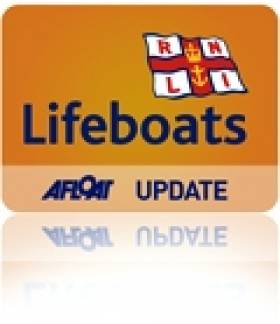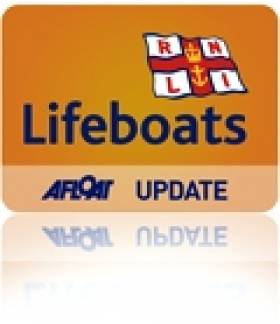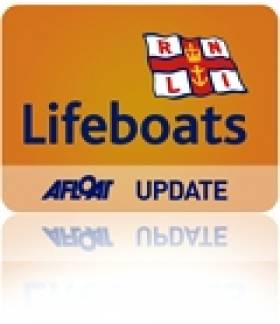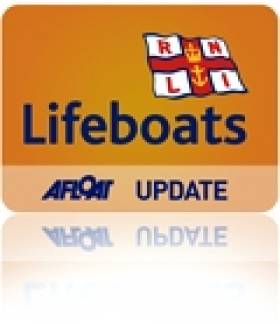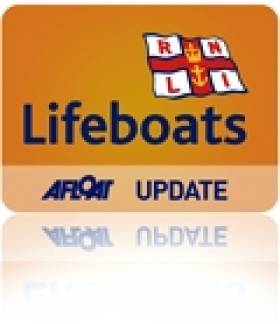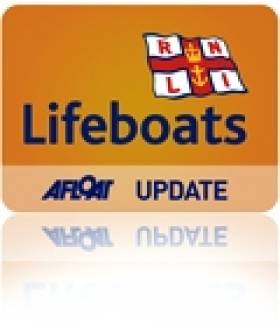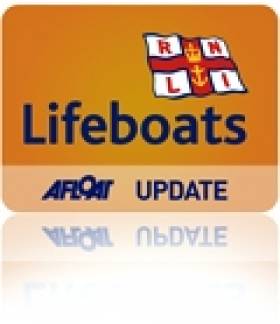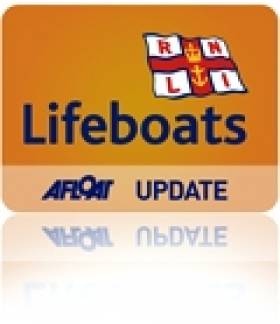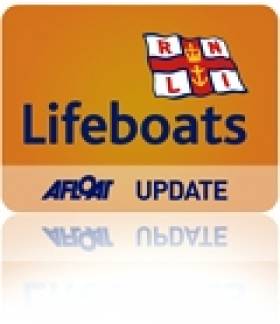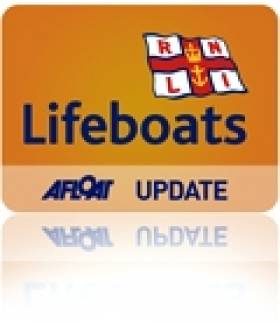Displaying items by tag: Lifeboats
#RNLI - Lough Ree RNLI aided 10 people in two separate callouts over the weekend.
The first call came just before 7pm on Saturday (12 July) following a report that two craft vessels had ran aground on the east shore of Inch McDermott. The volunteer crew launched their inshore lifeboat within minutes at 7.06pm.
At the scene, the crew discovered that a 30ft cruiser with two adults on board has suffered engine problems and had drifted ashore.
Meanwhile, a passing 80ft barge with four adults on board that had attempted to give assistance went aground herself.
The lifeboat eased the cruiser off the rocks and gave her into the care of a passing cruiser that had stopped to provide any assistance, before towing the barge back into deeper water.
Thankfully the barge had not suffered any damage and was able to tow the cruiser to Ballyleague. The lifeboat crew extended thanks to the crew of the cruiser Enchantress for their assistance.
The lifeboat crew was called upon for a second time at 4.42pm on Sunday afternoon (13 July) when a cruiser ran aground in the same area.
On scene a 33ft cruiser had grounded with four adults on board. The craft was eased back into deeper water and, after checking for damage, she was able to proceed on her journey.
#RNLI - Arklow RNLI’s volunteers gave the World Cup final the boot last night (Sunday 13 July) to respond to a pleasure craft in difficulty with three people on board.
Most of the lifeboat crew were settling down to watch the game at 8pm when the pager alert came in. The crew dropped what they were doing and made straight for the lifeboat station.
Within minutes of the alert, the all-weather lifeboat Ger Tigchlearr was en route to the distressed vessel, which was a short distance from the Roadstone Jetty, south of Arklow Harbour.
Once on scene it was established that the pleasure craft was taking on water and the three crew members were evacuated to the lifeboat.
A tow line was set up and the small pleasure craft was towed back to Arklow lifeboat station, where the volunteers brought the vessel safely up on to the inner slipway.
The three crew of the stricken pleasure craft were brought ashore safely at the lifeboat station.
Following the shout, Arklow RNLI deputy launching authority Declan Smullen gave "thanks to all of our volunteers who drop everything in their personal lives when the pagers sound and go to sea in all weathers, 24/7, to save lives at sea."
Arranmore Lifeboat Rescues Two From Drifting Punt
#RNLI - Following last week's assisting of nine people in two separate yacht breakdown incidents, Arranmore RNLI were out again yesterday (10 July) to rescue a man and a woman from a 14ft punt off the Donegal coast.
The volunteer crew launched their lifeboat at 4.30pm following a report from Malin Head Coast Guard that the fibreglass punt had suffered a broken outboard engine and broken oar in the Crohy Head area.
The all-weather lifeboat, under coxswain Anton Kavanagh and with six crew on board, made its way to the scene at Trawenagh Bay, six miles out of Arranmore.
Irish Coast Guard helicopter Rescue 118 was also tasked to the scene, and spotted the casualty vessel shortly after 5pm at the mouth of Trawenagh Bay.
Weather conditions at the time were good, with a calm sea and clear visibility.
At the scene the lifeboat crew transferred the punt's two passengers onto the safety of the lifeboat before returning them to shore.
Using the station's Y-class lifeboat, the crew towed the stricken punt to safety at Black Point slipway between Trawenagh and Crohy.
Speaking following the callout, Kavanagh said: "This was a joint operation between ourselves and the coastguard and we were happy to be able to return the two people safe and well back to Black Point slipway this evening."
#RNLI - On 14 July our friends across the Irish Sea at Blackpool RNLI will celebrate 150 years of lifesaving.
The station was established in 1864 – 40 years after the RNLI was founded – and has been operated by a large team of dedicated volunteers ever since.
During its 150-year history, the charity’s lifeboats in Blackpool have launched on 1,898 occasions and have rescued 625 people.
A great deal has changed for the station in that time. The first lifeboat station to be built in Blackpool cost £170 – in sharp contrast to today’s station running costs, which total £85,000 per year.
The cost of RNLI lifeboats has also changed dramatically. Samuel Fletcher of Manchester, the station’s second lifeboat, entered service in 1885 at a cost of just £398. This sum is considerably smaller than the £214,000 price tag of the current Atlantic 85 William & Eleanor.
Running costs are not the only thing that has changed in the 150 years since Blackpool RNLI was established. The number of calls for help has also changed significantly.
In the first 100 years of service Blackpool’s RNLI volunteers had an average of just two service calls per year. However, for over a decade now the station's volunteers have launched on average 64 times each year.
On some occasions callouts are straightforward and simple but on others the rescue operations are challenging, dangerous and demand extraordinary levels of seamanship, skill and bravery.
During Blackpool RNLI’s 150 years of saving lives at sea, the charity’s volunteers have been awarded six medals for gallantry, three silver and three bronze.
The most recent medals for gallantry were awarded to Keith Horrocks MBE and Phil Denham in 1988, awarded in recognition of the courage, skill and determination they displayed when both inshore lifeboats were involved in the rescue of two people in very confused seas.
Blackpool RNLI volunteer lifeboat operations manager Keith Horrocks MBE said: "Our RNLI lifeboat station in Blackpool has a very long and proud history of saving lives at sea.
"Our 150th anniversary is a significant milestone and provides a timely opportunity to remember the hundreds of men and women who have volunteered for the RNLI in Blackpool since 1864.
"Many things have changed for the charity since 1864 but the dedication and enthusiasm of our volunteers has not."
#Lifeboats - Portrush RNLI's all-weather lifeboat was launched on Saturday 5 July to reports of kayakers in difficulty at the Carrick-a-Rede rope bridge.
Although the sun was shining and it seemed like a good day for kayaking, the weather conditions at sea were choppy with a southwesterly wind that picked up what Independent.ie described as a 'freak wave' that capsized the group.
Two of the kayakers ended up on the rocks at Carrick-a-Rede and the coastguard rescue team were deployed to pick them up while the Portrush lifeboat stood by to offer safety assistance.
Two of the kayaking party who tried to make it back to base were found struggling as the tide changed, and were picked up by the Portrush all-weather crew along with their kayaks.
The party and their kayaks were then transported safely back to Portrush Harbour, where the kayakers disembarked. The whole operation took approximately three hours.
Portrush RNLI had a visiting coxswain on board, Anthony Barclay from Moelfre Lifeboat Station in Anglesey, North Wales.
One of Portrush’s previous lifeboats, Richard Evans, was named after one of the RNLI’s greatest heroes, a holder of two RNLI gold medals for bravery who also hailed from Moelfre.
Barclay said: "It was a privilege to cox the Portrush lifeboat today, and myself and the crew were pleased to have brought the kayakers safely back to Portrush Harbour."
In other news from Portrush, lifeboat chair James Heaney and operations manager Robin Cardwell were presented with a lovely gift from Dorma Healey and her son Steven recently.
On behalf of the station, they accepted a silver medal belonging to Dorma's father Sam Cunningham, ex-coxswain of the Portrush Lifeboat.
The medal was awarded to Cunningham for his outstanding seamanship in the rescue of a number of Greek seamen on the ship Argo Delos, which had run aground just off Malin Head on 2 October 1960.
The rescue was long and difficult in very rough weather, and the lifeboat was on service for over 14 hours.
In all 14 lives were saved thanks to the dedicated volunteer crew of the lifeboat. Each crew member received a ‘Thanks on Vellum’ from the RNLI and special tribute, with each of the crew also receiving an engraved silver tankard in recognition from the Royal Navy's HMS Leopard, which had also helped in the rescue.
Dorma Healy was delighted to present her father's medal to the station. This medal is unique in that it comes with an identical miniature silver medal, which was presented to Cunningham’s wife Dorothy.
For this rescue, the second coxswain at that time, Robert McMullan, also received a bronze medal for his courage displayed during the rescue.
This bronze medal is also displayed in the lifeboat station and was presented by his son Robert, also coxswain of the Portrush lifeboat.
Lough Ree Lifeboat Assists Seven In Two Weekend Callouts
#Lifeboats - Lough Ree RNLI assisted seven people whose vessels got into difficulty in two separate callouts over the weekend.
The volunteer crew was first requested to launch their inshore lifeboat at 6.20pm on Saturday 5 July following a report that a cruiser was experiencing engine problems off Goat Island.
- The crew responded and went to the assistance of three people on board the 30ft craft. The lifeboat towed the casualty to Ballyleague Marina, returning at 9.20pm.
The lifeboat had a second callout on Sunday 6 July at 6.57pm, this time to assist a yacht with a failed engine off the north end of Nun's Island.
The lifeboat launched at 7.08pm and towed the craft to Hodson Bay. There were two adults and two children on board.
Meanwhile, Lough Ree RNLI recently held its open day at the lifeboat station, during which it welcomed Junior Cert student Liam Chartan from Athlone Community College.
Chartan had been given a project for his exams based on a theme entitled 'My Inspiration' and chose the RNLI, and Lough Ree Lifeboat Station, in particular, as his inspiration – as he lives only a ‘shout’ away from the station and has been inspired by the crew's activities since they commenced two years ago.
Chartan designed his project around a miniature replica of the lifeboat, the Dorothy Mary, and a pedestal with the instantly recognisable RNLI motif.
"When Liam returns from his holidays we hope to have him back to the station to observe a full training exercise," said Liam Sherringham, Lough Ree RNLI volunteer lifeboat press officer.
"We hope he is surely headed for a volunteer crew role in the future, and we wish him well with his exam results."
Arranmore Lifeboat Assists Two Yachts In Poor Weather
#RNLI - Arranmore RNLI in Donegal has assisted nine people after two yachts got into difficulty within five hours earlier this week.
At 12.30pm on Wednesday 2 July, the volunteer lifeboat crew responded to a call for assistance from a yacht which had got into difficulty west of Bloody Foreland.
The 37ft yacht, with seven crew members on board, was experiencing problems with its engine and sails.
On arrival, the lifeboat crew stood by. but with deteriorating weather conditions and a 3-4 metre swell, coxswain Anton Kavanagh decided to escort the yacht to safety until it was safe to secure a tow rope.
As both the lifeboat and the yacht reached the lee side of Arranmore at Beal a’ Chreesh, the crew managed to secure a tow and brought the vessel into Burtonport, where two of the yacht’s injured crew were then transferred to Letterkenny General Hospital by ambulance.
Meanwhile, at around 2.15pm another 10m yacht with two crew members on board got into difficulty eight miles northwest of Arranmore when the vessel’s boom broke.
With no immediate danger, the skipper of the yacht began to make his way towards Burtonport until the lifeboat could return from its first call and escort them into harbour as a safety precaution in what were rapidly deteriorating weather conditions.
Speaking after both rescues, Arranmore RNLI mechanic Philip McCauley said: "For four to six weeks we were quiet and now have responded to six calls in just under two weeks, but I suppose that’s the nature of the business we are in and the volunteer lifeboat crew will always be ready to go out whenever we get the call.
"We were pleased to assist both casualty vessels and their crews today; it is all part of the service."
The lifeboat station at Arranmore is experiencing one of its busiest summers with calls for assistance to help locate missing swimmers, rescue injured fishermen and carry out medical evacuations.
Elsewhere, the Clogherhead RNLI volunteer lifeboat crew launched yesterday morning (Friday 4 July) to the aid of a fishing vessel with engine failure located 3 miles north-east of Dunany Point in Co Louth.
The all-weather lifeboat was launched and underway by 7.25am. On arrival at the scene, coxswain Tomas Whelahan and his crew assessed the situation, and together with the skipper of the casualty vessel it was decided to tow the disabled vessel to Port Oriel.
There were no injuries and the boat was safely tied up at 10:24am.
Dunmore East Lifeboat Assists Vessel With Engine Failure
#RNLI - Dunmore East RNLI's volunteer lifeboat crew launched yesterday (Tuesday 1 July) to assist a 17ft vessel that suffered engine failure two miles south of the harbour.
At 7:40pm the lifeboat launched at the request of the Irish Coast Guard to assist the vessel with two people on board, located just off Red Head.
Five minutes after launch, the Trent class lifeboat Elizabeth and Ronald arrived on scene to find the motor vessel drifting 300m from shore and both passengers wearing life jackets.
The volunteer RNLI crew took the casualty under tow and arrived safely back at Dunmore East Harbour at 8:05pm.
Dunmore East RNLI coxswain Roy Abrahamsson said: "The conditions this evening were very good, which helped the whole operation run smoothly."
Busy Weekend For Wicklow Lifeboats
#RNLI - Wicklow RNLI's volunteers had a busy weekend answering three calls for assistance in a 24-hour period.
The first callout was on Saturday afternoon (28 June) at the start of the Round Ireland Yacht Race in Wicklow Bay when a competing yacht reported it was taking on water after sustaining damage on the race start line.
The lifeboat, under the command of coxswain Nick Keogh, and the inshore lifeboat escorted the 37-foot yacht with six crew safely into Wicklow Harbour.
The second callout came on Sunday morning (29 June) when both lifeboats were launched shortly before 8.30am to investigate a report of an injured man near Bride's Head.
The inshore lifeboat crew were on scene eight minutes later and found an injured man on a beach near Bride's Head. First aid was administered to the casualty after he sustained leg injuries from a fall off nearby cliffs.
The man was taken off the beach on the inshore lifeboat, transferred to the all-weather lifeboat and taken back to Wicklow Harbour. The lifeboat, under the command of Second Coxswain Ciaran Doyle, was met on arrival by a waiting ambulance crew at the East Pier.
Speaking following the callout, Wicklow RNLI press officer Tommy Dover said: "The casualty was extremely lucky and did not sustain any life-threatening injuries after his ordeal."
The third callout occurred on Sunday afternoon near the entrance to Wicklow Harbour, when the inshore lifeboat came to the assistance of a small boat with engine failure.
Helm Mark Kavanagh and two crew brought the boat with one person on board safely ashore.
#RNLI - After a series of 999 emergency calls reporting an object crashing into the sea off Bray, Co Wicklow yesterday evening (29 June), a brief search by the volunteer RNLI lifeboat crew from Dun Laoghaire discovered a giant Mickey Mouse balloon on the water.
Several callers to the Irish Coast Guard's Marine Rescue Co-ordination Centre in Dublin reported an object crashing into the water 1km off the Bray seafront.
Several paragliders had been operating in the area recently, and there were fears that the object might have been one of these in difficulty.
Arriving on scene, the all-weather lifeboat crew of seven recovered a large inflatable Mickey Mouse balloon that had fallen into the sea and was being carried by the light breeze and flood tide towards the cliffs at Shanganagh.
"We're happy that this was a call made with good intent and calling 999 and asking for coast rescue is always the best course of action," said Stephen Wynne, lifeboat operations manager at Dun Laoghaire.
"And in this case, we were particularly happy to assist Mickey Mouse, one of the all-time favourite cartoon characters."


























